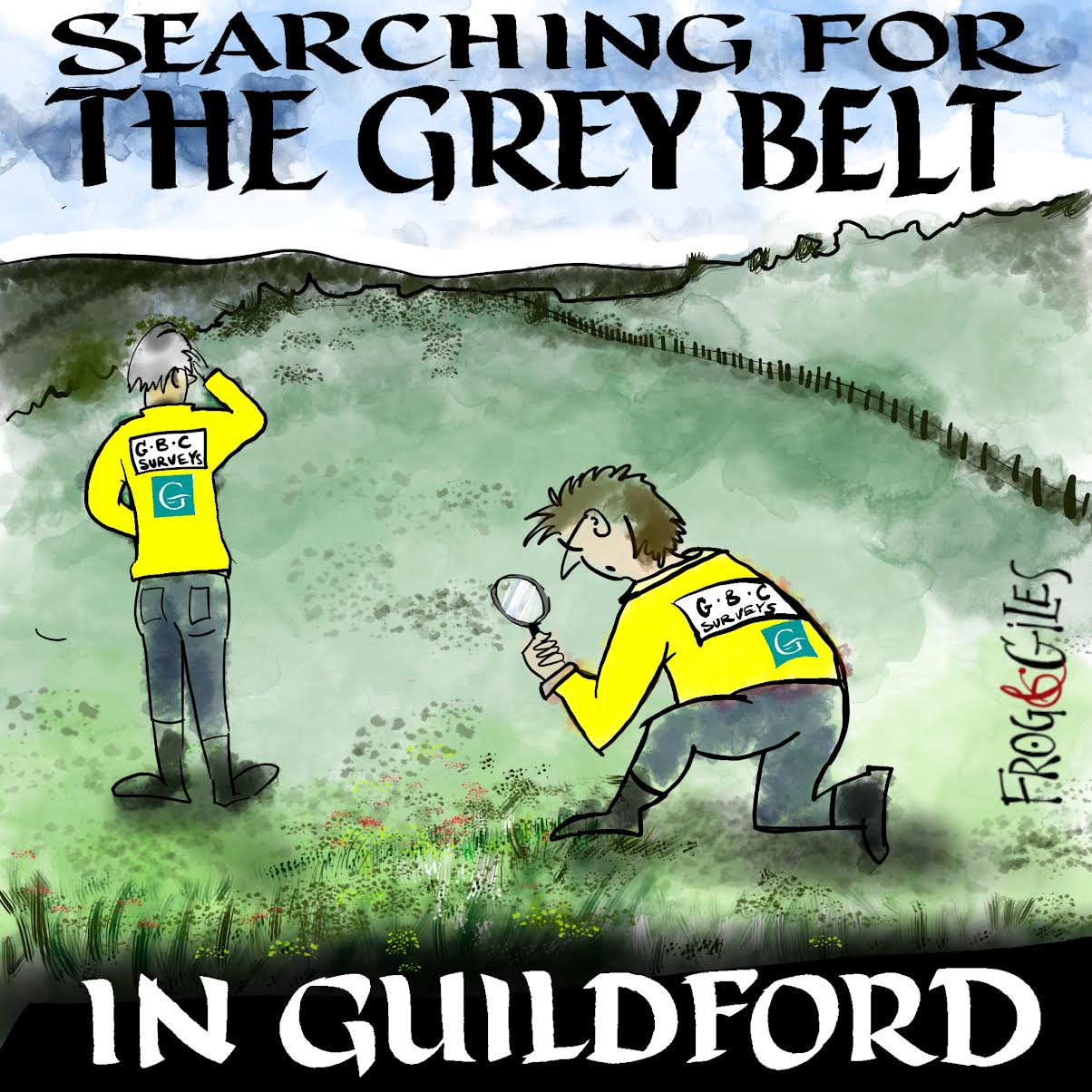 Abraham Lincoln
If given the truth, the people can be depended upon to meet any national crisis...
Abraham Lincoln
If given the truth, the people can be depended upon to meet any national crisis...
 Guildford news...
for Guildford people, brought to you by Guildford reporters - Guildford's own news service
Guildford news...
for Guildford people, brought to you by Guildford reporters - Guildford's own news service
Opinion: Great Store, Wrong Site, Bad Plan
Published on: 4 Nov, 2012
Updated on: 8 Nov, 2012
By John Rigg
Director, Guildford Vision Group
At the Planning Committee this Tuesday, 6th November, councillors have a golden opportunity to set the town on a new path, to take the first step to ensure our town flourishes well into the 21st century, and to open an exciting new era of attractive, pedestrian and business-friendly planning in the town centre.
Their first step must be to reject Waitrose’s application for a supermarket on the Bellerby Theatre site along with 168 surface parking spaces.
There really can be no sense in adding to the two main challenges Guildford faces – congestion and insufficient housing that local employees can afford.
 However you play around with the traffic studies, across the fragile town centre gyratory and feeder system, it’s plain that congestion, and pedestrian and cyclist safety, in York Road and the surrounding streets will get worse, not better. You don’t have to be a traffic engineer to work that out. It’s bad planning.
However you play around with the traffic studies, across the fragile town centre gyratory and feeder system, it’s plain that congestion, and pedestrian and cyclist safety, in York Road and the surrounding streets will get worse, not better. You don’t have to be a traffic engineer to work that out. It’s bad planning.
And the plan changes a site with previous permission for 75 affordable units to one that gives us just 18. That’s not progress in tackling the housing shortage, is it? It’s bad planning.
 And where’s the logic of approving 168 parking spaces in the town centre on the same night the Committee is looking at a ‘Park & Ride’ scheme in Onslow – presumably with the avowed intention of keeping cars out of the town centre? Again, it’s just plain bad planning.
And where’s the logic of approving 168 parking spaces in the town centre on the same night the Committee is looking at a ‘Park & Ride’ scheme in Onslow – presumably with the avowed intention of keeping cars out of the town centre? Again, it’s just plain bad planning.
But the council is in a pickle. Someone there had the bright idea of a quick deal for a site the Council owns. It is unlikely any private landowner could successfully apply the same planning interpretation, yet GBC have pressed ahead. The irony is that the site may well actually be worth more as a residential development. Is that good financial planning?
The application coming before the Committee on Tuesday night carries an officer’s recommendation to approve. It runs to 69 pages. That suggests to me that the logic of the plan is not plain to see and is an attempt to ‘prove’ the wisdom of the scheme by sheer weight of the paper rather than the weight of the argument.
Guildford Vision successfully challenged the Council’s last attempt to adopt two unlawful documents; expensive pieces of work that sadly led us nowhere but racked up wasted costs. We are challenging this application as well.
It’s clear this time the Council has brought in its own legal counsel to blind us all with planning jargon.
But how do you support the unsupportable? When there is little merit in an application, why do the officers try so hard to stop it being thrown out on its ear in the way much of the community might wish? We would all like to see Waitrose in town but not on the Bellerby site. It just doesn’t make sense and it’s bad planning.
The officer’s recommendation includes such gems as it will only cause ‘acceptable’ congestion (that includes a likely 400m queue eastwards along York Road, back as far as Victoria Road!). In that for the Park & Ride scheme, it declares no new planning application has any duty to solve existing problems. Is this the quality of planning we want to see for our historic town centre? Shouldn’t we aspire to something more visionary and progressive?
Thus the council officers are left only with the government’s new NPPF documents in favour of ‘sustainable development’ to support their recommendation. The NPPF assumes that there’s a solid up-to-date, supportive evidence base in existence. Guildford’s is sadly lacking in almost every respect. I don’t believe the NPPF was ever intended to offer carte blanche for bad planning.
The other irony is, of course, that the NPPF used in this way would then apply to every large site in Guildford. Solum, the station developer, has spotted this already and has written to the council to seek parity of treatment if Waitrose is approved, i.e. it will expect no resistance to its station supermarket plan and will want significant surface parking to go with it. How can the Council refuse? And if it does, are we council tax payers really happy to pick up the inevitable legal costs of developers’ challenges?
So it will be open house for more supermarkets and parking and more congestion. This really is bad planning.
This is all at the very time the council is committed to producing a new plan for the town, embracing development on a large scale. GBC or its consultants have advocated up to 600,000 sq ft of new retail space in Guildford, a 60% increase, along with additional car parks. Solum wants to put up to 350 apartments, a hotel, a supermarket and parking on the station. But the evidence base is very poor.
There are no proper current traffic surveys, and the retail calculations are based on a 2006 study that takes no account of the recessions and rise of internet shopping. Thus, irrespective of the arguments about good or bad planning, the Waitrose application is simply premature.
We also surely shouldn’t rely today on retail-led regeneration for our town; rather we should plan our economic growth around those activities that are already delivering real and growing GDP – the University and Research Park, hubs like Slyfield and the Business Park – all areas that need a proper and productive connection with the town; one that’s not there now.
So Waitrose should wait. Using established planning procedures and conventions, the planning committee is entitled to give the response that the Waitrose application is premature. It can also declare that it fails the accepted sequential test and therefore refuse it.
That would be good planning and a great first step towards creating a properly consulted professional masterplan for our lovely town that residents can all buy into.
And to give those councillors not on the planning committee the chance to reflect their constituents’ views over this crucial matter, it’s worth pointing out that under GBC’s own rules, it only takes two independently-minded councillors to refer the application to full Council. That might advance the new Executive’s welcome desire for greater openness and transparency in the conduct of Council business, and give residents more chance to speak out.
Responses to Opinion: Great Store, Wrong Site, Bad Plan
Leave a Comment Cancel replyPlease see our comments policy. All comments are moderated and may take time to appear. Full names, or at least initial and surname, must be given.

"Found any?" - "Nope, it all looks green to me!" (See Opinion: The Future is Congested, the Future is Grey)




Recent Articles
- Letter: 1950s Memories of Woodbridge Park House
- Sara Sharif Trial Latest – Prosecution Sums Up, Violence Towards Sara Became ‘Normalised’
- Ash Manor School Closed After Fire Breaks Out in Outbuildings
- Parish Council and CPRE Pleased with MP’s Support for Call In of Solar Farm Decision
- Letter: The Active Travel Proposal Is the Safest Option for London Road
- Select Committee Votes to Refer London Road Decision Back to SCC Cabinet
- Letter: SCC Chose Not To Verify Our Survey
- Letter: Insensitive Management of Diseased Ash Trees Has Had Devastating Impact
- Dragon Review: Rebus – A Game Called Malice – Yvonne Arnaud Theatre
- MP Supports Call In Request of ‘Nationally Significant’, Solar Farm Planning Decision


Recent Comments
- Bethan Moore on Letter: SCC Chose Not To Verify Our Survey
- Mike Smith on Photo Feature: Freiburg, Guildford’s Twin – Friends for 45 Years
- Derek Payne on SCC Cabinet’s Decision to Scrap London Road Scheme ‘Called-in’ by Select Committee
- John Perkins on Letter: LRAG Has Morphed from a Cross-community Group into a Pressure Group
- Maria Duarte on Sara Sharif Trial Latest – Prosecution Sums Up, Violence Towards Sara Became ‘Normalised’
- Bethan Moore on Letter: We Need to Stop Shouting and Start Listening
Search in Site
Media Gallery
Dragon Interview: Local Artist Leaves Her Mark At One of England’s Most Historic Buildings
January 21, 2023 / No Comment / Read MoreDragon Interview: Lib Dem Planning Chair: ‘Current Policy Doesn’t Work for Local People’
January 19, 2023 / No Comment / Read MoreA3 Tunnel in Guildford ‘Necessary’ for New Homes, Says Guildford’s MP
January 10, 2023 / No Comment / Read More‘Madness’ for London Road Scheme to Go Ahead Against ‘Huge Opposition’, Says SCC Leader
January 6, 2023 / No Comment / Read MoreCouncillor’s Son Starts Campaign for More Consultation on North Street Plan
December 30, 2022 / No Comment / Read MoreCounty Council Climbs Down Over London Road Works – Further ‘Engagement’ Period Announced
December 14, 2022 / No Comment / Read MoreDragon Interview: GBC Reaction to the Government’s Expected Decision to Relax Housing Targets
December 7, 2022 / No Comment / Read MoreHow Can Our Town Centre Businesses Recover? Watch the Shop Front Debate
May 18, 2020 / No Comment / Read More







Roy Hogben
November 5, 2012 at 11:07 pm
Another opportunity lost. Any town centre development should have unlimited car parking spaces……as long as they are undergound! This town centre site should be six stories high but with a minimum of four stories to maximise density on this valuable site.
Obviously the traffic situation is based on the owner (GBC) seriously compromising any adverse report.
Roy Hogben.
Former GBC Councillor and Design & Heritage Champion.
Alan Cooper
November 6, 2012 at 9:47 am
The idea of splitting York Road with another set of traffic lights is total lunacy and together with the problems in Onslow Street caused by the pedestrian lights in Millbrook by Debenhams will undoubtedly bring the town centre to a virtual standstill, during busier times.
These plans must surely be passed by non drivers or members of the council who commute in to Guildford by train.
Merilyn Spier
November 6, 2012 at 3:27 pm
Not only will splitting York Road with another set of traffic lights cause additional traffic problems but will be significantly less safe for families and children accessing Sandfield School and the Guildford Children’s Centre. Crossing streets with young children is not a simple matter. Often a parent is pushing a stroller and having to monitor one or more young children who are walking or on scooters.
I can envisage times when the pedestrian refuge could be overflowing with people and pushchairs and the signals will have changed. The start of the school day is at the morning peak traffic period and the end of the school day is at the beginning of the build-up for evening peak traffic when pedestrian problems will be exacerbated at this proposed junction.
Similarly, for reasons of pedestrian safety, it is important to retain the existing underpass at the junction of York Road, Onslow Street and Woodbridge Road since it provides complete separation of traffic and pedestrians at an intensively used roundabout.